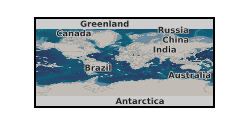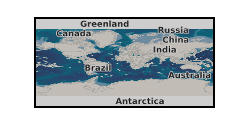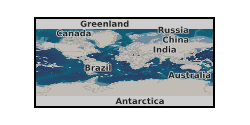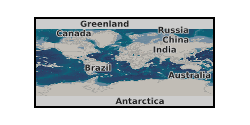National Oceanography Centre
Type of resources
Topics
Keywords
Contact for the resource
Provided by
Years
Formats
Representation types
Update frequencies
Resolution
-
This marine geophysical and sampling survey took place over two legs (CD91A & CD91B) in March and April 1995 in the Hebridean Shelf edge area aboard the RSS Charles Darwin as part of the LOIS Shelf Edge Study. Sea floor data were collected using a echo-sounder and TOBI sidescan sonar. Seabed sampling data was gathered using Kasten corer, box corer, gravity corer. CTD, water sampling ADCP current profiler were also used. Seimic profiling was not collected due to weather conditions. Technical details of the survey are contained in POL Cruise Report 20.
-
This marine sampling survey took place in July and August 1995 in the Hebridean Shelf edge area aboard the RSS Challenger as part of the LOIS Shelf Edge Study. Seabed sampling data was gathered using a box corer. For technical details of the survey contact Plymouth Marine Laboratory.
-

This database is from series of laboratory experiments designed to explore the effect of hydrate cementaion on some sands. This dataset is part of NERC Arctic Landslide-Tsunami Project (http://arp.arctic.ac.uk/projects/landslide-tsunami/) and has been presented in International conference and Journal article (under review) namely, 1) Madhusudhan, B.N. and Clayton, C.R.I. (2016) Influence particle size on strength of gas hydrate cemented granular materials. Wuttke, F., Bauer, S. and Sanchez, M. (eds.) In Energy Geotechnics. CRC Press. 742 pp, pp. 445-449. (doi:10.1201/b21938-71). 2) Madhusudhan,B.N, Clayton, C.R.I. and Priest, J.A ‘1 The Effects of Hydrate on the Strength and Stiffness of some Sands’. Under-review in Journal of Geophysical Research – Solid Earth.
-

The North Sea Interactive (NSI) project was an 8-month NERC funded project led by Heriot-Watt University, in collaboration with the BGS and NOC. The aim of the project was to develop a new decision-support tool that would translate existing marine environmental data into an interactive mapping product for the offshore oil and gas industry. The objectives of the project were achieved through the integration of the North Sea Benthos database (UKBenthos) with NERC's regional North Sea marine sediment data (BGS) and layers of modelled hydrodynamics (NOC). Aligning the biological, chemical, geological and hydrodynamic datasets in a single GIS product provides the oil industry and government regulators with a practical means of accessing this important archive of environmental data. The North Sea Benthos database (UKBenthos) was developed by Heriot-Watt University on behalf of UKOOA (now Oil and Gas UK) in the 1980s. Alongside macrobenthos, the database includes sediment properties, concentrations of aromatic compounds, total oil and metals. It currently includes data from 1975 to 2011 from 237 platforms and is continually being updated as new survey results are received by Oil and Gas UK.
-

Data for the figures in the manuscript: S. K. Sahoo, H. Marin-Moreno, L. J. North, I. Falco-Suarez,B. N. Madhusudhan, A. I. Best and T. A. Minshull (2018).Presence and consequences of co-existing methane gas with hydrate under two phase water-hydrate stability conditions , Journal of Geophysical Research: Solid Earth. https://doi.org/10.1029/2018JB015598
-

This excel spreadsheet contains P-wave and S-wave velocity and attenuation data calculated with a novel rock physics model for hydrate bearing sediments. The model has been published in: Marín-Moreno, H., S. K. Sahoo, and A. I. Best (2017), Theoretical modeling insights into elastic wave attenuation mechanisms in marine sediments with pore-filling methane hydrate, Journal of Geophysical Research: Solid Earth, 122(3), 1835-1847, doi:10.1002/2016JB013577.
-
This dataset contains particulate and dissolved organic carbon concentrations, nutrients (ammonia, nitrates, phosphate), alkalinity, pH, particulate organic nitrogen, delta-C-13 and delta-15-N isotopes, fluorescence and absorbance from river water samples. Data come from 41 rivers from around Great Britain, sampled on a monthly basis during 2017. LOCATE (Land Ocean CArbon TransfEr) is a multi-disciplinary project that undertakes coordinated sampling of the major rivers in Great Britain to establish how much carbon from soils is getting into rivers and estuaries and to determine what is happening to it. LOCATE is a multidisciplinary NERC project involving the National Oceanography Centre, the British Geological Survey, the Centre for Ecology and Hydrology and the Plymouth Marine Laboratory, with assistance from the University of Lancaster, University of Durham, University of Hull, the University of the Highlands and Islands and the Environment Agency. Full details about this dataset can be found at https://doi.org/10.5285/08223cdd-5e01-43ad-840d-15ff81e58acf
-
This dataset contains monthly measurements of major and trace elements from 41 rivers around Great Britain. The samples were collected as part of the Land Ocean Carbon TransfEr (LOCATE) project during 2017 and they were analysed using Inductively coupled plasma mass spectrometry (ICP-MS). LOCATE was a multi-disciplinary NERC project that undertook coordinated sampling of the major rivers in Great Britain to establish how much carbon from soils is getting into rivers and estuaries and to determine what is happening to it. It involved the National Oceanography Centre, the British Geological Survey, the UK Centre for Ecology and Hydrology and the Plymouth Marine Laboratory, with assistance from the University of Lancaster, University of Durham, University of Hull, the University of the Highlands and Islands and the Environment Agency. Full details about this dataset can be found at https://doi.org/10.5285/ef880531-08b3-477d-a69e-3b28beb562d2
-

The excel table presents the high-resolution LA-MC-ICP-MS Pb isotope data (± 2S%) produced for the Paleocene interval of Fe-Mn crust core sample 085_004 recovered in 2016 during the JC142 expedition to Tropic Seamount for the MarineE-Tech project. A detailed description of the sample can be found in Josso et al., 2019 and 2020. The Scripts data are Matlab and R readable file presenting all scripts and built-in functions used during the processing of the data to demonstrate the presence of astronomical imprint on the cyclicity of the Pb isotope ratios.
-

The dataset gather data from a dual experiment conducted to the study (i) the stress dependence of ultrasonic (elastic) waves and permeability of salt rocks, and (ii) the monitoring of controlled dissolution in an intact halite sample and a cracked (fractured) one. The tests were run in the high-pressure room-temperature (20°C) experimental setup for flow-through tests at the National Oceanography Centre, Southampton (NOCS) (Falcon et al. 2016). The rig consists of a triaxial vessel equipped with (i) ultrasonic sensors that allow measuring P- and S-wave velocities and their attenuation factors using the pulse echo method (McCann and Sothcott, 1992), and (ii) two rigs of electrodes embedded into the rubber sleeve of the pressure vessel for collecting electrical resistivity data that can be used to build up an electrical tomography of the sample (North el al. 2013). The rig has automatic control of both confining and pore pressure (ISCO EX-100D system). For the operating conditions and in homogeneous samples, the bulk electrical resistivity error is <1% for bulk resistivities <100 Ω m, increasing up to 5% with the degree of heterogeneity and above this resistivity value, at frequencies 1–500 Hz (North et al., 2013). Regarding the ultrasonic data, the technique and instrumentation used in this experiment provide velocity precision of ± 0.1% and accuracy of ± 0.3% (95% confidence), and attenuation accuracy of ± 0.1 dB cm-1 within the frequency range 300-1000 kHz (Best, 1992). The dataset presented here show the ultrasonic data at a single frequency of 600 kHz, obtained from Fourier analysis of broadband signals. Permeability to water and to N2 can be both determined with the aid of integrated flowmeters and pore pressure sensors both up- and downstream of the rock sample. The rock samples include: Pre-Cambrian salt (unknown well, Pakistan (source: www.likit.co.uk/)), Cambrian salt (unknown well, Tunguska Basin, Russia), Triassic salt (Arm Hill #1 well, NW Lancashire, UK), and Messinian salt (3A GN3 S02 well, core # 19, near Marianopoli, Sicily). 2.5 cm length, 5 cm diameter core plugs were extracted from precursor rocks, composition estimated by X-ray diffraction analysis, and connected porosity by He-pycnometry. Falcon-Suarez, I., North, L., Amalokwu, K., Best, A., 2016. Integrated geophysical and hydromechanical assessment for CO2 storage: shallow low permeable reservoir sandstones. Geophysical Prospecting 64, 828-847, http://doi.org/10.1111/1365-2478.12396. McCann, C., Sothcott, J., 1992. Laboratory measurements of the seismic properties of sedimentary rocks. Geological Society, London, Special Publications 65, 285-297, https://doi.org/10.1144/gsl.sp.1992.065.01.22. North, L., Best, A.I., Sothcott, J., MacGregor, L., 2013. Laboratory determination of the full electrical resistivity tensor of heterogeneous carbonate rocks at elevated pressures. Geophysical Prospecting 61, 458-470, https://doi.org/10.1111/j.1365-2478.2012.01113.x.
 NERC Data Catalogue Service
NERC Data Catalogue Service